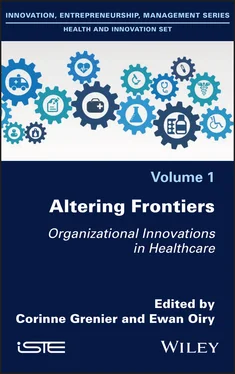1 Cover
2 Title Page Health and Innovation Set coordinated by Corinne Grenier Volume 1
3 Copyright First published 2021 in Great Britain and the United States by ISTE Ltd and John Wiley & Sons, Inc. Apart from any fair dealing for the purposes of research or private study, or criticism or review, as permitted under the Copyright, Designs and Patents Act 1988, this publication may only be reproduced, stored or transmitted, in any form or by any means, with the prior permission in writing of the publishers, or in the case of reprographic reproduction in accordance with the terms and licenses issued by the CLA. Enquiries concerning reproduction outside these terms should be sent to the publishers at the undermentioned address: ISTE Ltd 27-37 St George’s Road London SW19 4EU UK www.iste.co.uk John Wiley & Sons, Inc. 111 River Street Hoboken, NJ 07030 USA www.wiley.com © ISTE Ltd 2021 The rights of Corinne Grenier and Ewan Oiry to be identified as the authors of this work have been asserted by them in accordance with the Copyright, Designs and Patents Act 1988. Library of Congress Control Number: 2021934597 British Library Cataloguing-in-Publication Data A CIP record for this book is available from the British Library ISBN 978-1-78630-707-1
4 Foreword by Jean-Louis Denis Adaptation, Trust and Methodology
5 Foreword by Norbert Nabet The Challenges of Altering Frontiers: For Other More Collaborative Approaches
6 Introduction The Challenges of “Altering Frontiers”: The Multiple Facets of Boundaries to Cross and Articulate
I.1. Altering frontiers: a boundary concept I.2. Conclusion I.3. References
7 PART 1: Innovations as Seen by StakeholdersIntroduction to Part 1 1 Recognition of Patients’ Experiential Knowledge and Co-production of Care Knowledge with Patients and Citizens in the 21st Century1.1. Introduction 1.2. From “empowerment” to the “patient revolution”, an international trend 1.3. From paternalism to different forms of participation and partnership with patients 1.4. Innovative practices 1.5. Conclusion 1.6. References 2 Innovative Organizations and Professional Strategies: The Nursing Professional Space2.1. Introduction: experimenting experimentation 2.2. Participatory evidence-based policy: a new conceptual framework? 2.3. Article 51: a full-scale test 2.4. The nursing space: a controlled extension 2.5. Conclusion: new ways of doing things 2.6. Appendix: examples of emancipatory innovations in the 1990s 2.7. References 3 Managed Communities of Practice in the Gerontology Sector: Case of a CoP of Gerontology Volunteers in Sweden3.1. Introduction 3.2. Context and questions 3.3. Conceptual framework 3.4. Illustrations 3.5. Conclusion 3.6. References
8 PART 2: Innovations on the Collective SideIntroduction to Part 2 4 Moving from Partitioning to Transversality in Operating Rooms using Robot-assisted Surgery4.1. Introduction 4.2. The context of operating rooms mobilizing the surgical robot 4.3. The issue of technical and non-technical skills in the context of robotic surgery 4.4. The effects of new technologies in terms of individual and collective skills 4.5. Viewing at the heart of robot-assisted surgery in urology 4.6. Discussion 4.7. References 5 Clinical Poles of Activity, an Opportunity for New Cooperation Between the Actors? The Case of a Hospital 5.1. Key elements and objectives of polar reform 5.2. Improving cooperation and better articulating the logics present in the hospital: challenges and theoretical identification 5.3. Context and methodology of the study 5.4. Modalities of cooperation permitted by the establishment of the clinical poles 5.5. Conditions for the use of articulations 5.6. Cooperation in a polar structure, some research avenues 5.7. References 6 Learning from Reforms Aiming to Disseminate Innovative Organizational Models: The Case of Family Medicine Groups in Quebec6.1. Introduction 6.2. Conceptual framework 6.3. Illustration of the analytical framework: the reflexive processes related to the implantation of family medicine groups in Quebec 6.4. Discussion 6.5. Conclusion 6.6. References 7 Variety and Performance of Innovative Organizational Structures: The Emergence of Territorial Support Platforms 17.1. Introduction 7.2. Context of the study 7.3. Conceptual framework 7.4. Empirical analysis 7.5. Conclusion 7.6. Acknowledgments 7.7. References
9 PART 3: Reflective Insights on Organizational Innovations in HealthcareIntroduction to Part 3 8 Proposals for New Approaches to Contributory Evaluation of Healthcare Pathways from Interface Organizations8.1. Introduction 8.2. Context and research questions 8.3. Framework for analyzing the processes of diffusion of organizational innovations: definition and principles (conceptual framework) 8.4. Empirical illustrations of the innovation diffusion processes supported by coordination platforms 8.5. Conclusion 8.6. Acknowledgments 8.7. References 9 Innovation and Absorptive Capacity of Organizations in the Healthcare Field9.1. Introduction: absorbing to innovate 9.2. Context and questions: the challenge of openness 9.3. Theoretical framework: the notion of organizational absorption capacity 9.4. Responses to the three OAC pitfalls: illustrations 9.5. Conclusion 9.6. References 10 Quality Management in Hospitals: The Two Faces of Rationalization Through Indicators10.1. Introduction: are quality indicators a managerial innovation? 10.2. Context and issues 10.3. Management tools and organizational rationalization dynamics 10.4. A dynamic of professional rationalization? 10.5. A dynamic of managerial rationalization? 10.6. Conclusion: rationalizing through indicators to rationalize “softly” 10.7. References
10 List of Authors
11 Index
12 Other titles from iSTE in Innovation, Entrepreneurship and Management
13 End User License Agreement
1 Chapter 4Table 4.1. Categorization of main types of communication (Blavier & Nyssen 2010)Table 4.2. Typical configuration of the operating room using the surgical robotTable 4.3. Spatial and temporal partitioning within and outside the operating ro...
2 Chapter 7Table 7.1. Data collection protocolTable 7.2. Characteristics of the seven structural configurations according to M...Table 7.3. Analysis of internal contingency factorsTable 7.4. Analysis of external contingency factors
1 Chapter 1 Figure 1.1. Continuum of patient engagement modalities Figure 1.2. The continuum of care practices. For a color version of this figure,... Figure 1.3. Different approaches to care. For a color version of this figure, se... Figure 1.4. Patients’ skills in frame of reference. For a color version of this ... Figure 1.5. The competence framework for collaborative practice and patient part... Figure 1.6. Distinctive record of the nature of patient-professional relationshi... Figure 1.7. Systemic transformation practice. For a color version of this figure...
2 Chapter 4Figure 4.1. Configuration of the team and operating room during the filmed proce...
3 Chapter 6Figure 6.1. Illustration of the theory of intervention described in the MSSS pol...
4 Chapter 7Figure 7.1. Contingency factors, organizational congruence and performance. For ...Figure 7.2. Expected organizational form of PTAs after situational analysis. For...
1 Cover
2 Table of Contents
3 Title Page Health and Innovation Set coordinated by Corinne Grenier Volume 1
4 Copyright First published 2021 in Great Britain and the United States by ISTE Ltd and John Wiley & Sons, Inc. Apart from any fair dealing for the purposes of research or private study, or criticism or review, as permitted under the Copyright, Designs and Patents Act 1988, this publication may only be reproduced, stored or transmitted, in any form or by any means, with the prior permission in writing of the publishers, or in the case of reprographic reproduction in accordance with the terms and licenses issued by the CLA. Enquiries concerning reproduction outside these terms should be sent to the publishers at the undermentioned address: ISTE Ltd 27-37 St George’s Road London SW19 4EU UK www.iste.co.uk John Wiley & Sons, Inc. 111 River Street Hoboken, NJ 07030 USA www.wiley.com © ISTE Ltd 2021 The rights of Corinne Grenier and Ewan Oiry to be identified as the authors of this work have been asserted by them in accordance with the Copyright, Designs and Patents Act 1988. Library of Congress Control Number: 2021934597 British Library Cataloguing-in-Publication Data A CIP record for this book is available from the British Library ISBN 978-1-78630-707-1
Читать дальше










